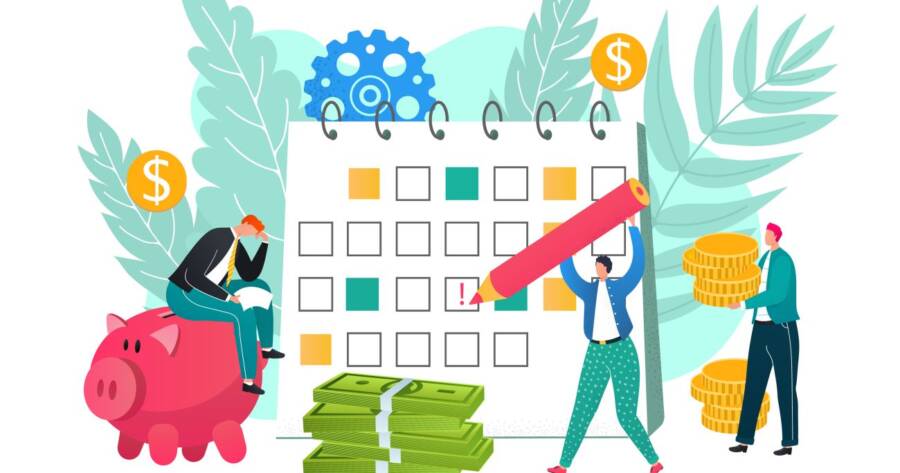Life is often unpredictable — and expensive. There’s no shortage of things that can randomly pop up and put immediate strain on your short-term budget. Ideally, you have some sort of emergency fund for these unexpected expenses. Or at least access to something like a credit card or line of credit. The interest charges associated with revolving credit products might be hard to swallow, but at least that bill will get paid.
Unfortunately, there are millions of Americans who simply don’t have those options. Emergency funds were already difficult to maintain, and that was before the pandemic and soaring inflation. Even credit cards are harder to get now, with lenders tightening up eligibility requirements for those with low credit scores.
Luckily, there are some handy apps that will front you some money until your next payday. So if you need a bit of an advance to cover an unexpected bill, try one of these apps.
What Are Payday Advance Loans?
Payday advance loans are exactly what they sound like. They are designed to be an extremely short-term loan of a smallish amount of money. Essentially, they will give you some or all of your next paycheck before it’s issued. Then, when your payday does arrive, you pay back the loan plus a small fee. Ideally, that concludes the transaction entirely.
However, traditional payday loans are being overtaken by apps. Unlike standard offers, these advances don’t come with interest. Instead, they typically charge a subscription fee or “expedited funding fees.” Many of them also collect money via tips. (Our advice? Don’t tip the companies making a profit of your financial struggles.)
There’s a bunch of these apps on the market right now, so let’s go over the pros, cons, and the costs of the most popular ones.
Earnin
- Amount: $100 to $500.
- Fees: Technically none, but asks for tips and offers additional services for recurring subscription fees.
- Speed: One to three business days, unless you pay for Lightning Speed feature.
- Repayment: Earnin automatically withdraws repayment from your bank account when your next paycheck arrives.
Earnin works best for hourly workers. In fact, it specifically doesn’t advertise itself as a payday advance app. Instead, it offers “access to earned wages.” That means you have to fill out a timesheet — or use location tracking to prove you were at work — to verify the amount of your next pay. The app will then deposit money directly into your bank account, and then take it back out when you get paid.
Earnin also provides automatic overdraft protection for a recurring tip of $1.50 a month. You can get money instantly if you opt into the Lightning Speed feature, which is $1.99 to $3.99 depending on amount borrowed.
Dave
- Amount: $5 to $100 or up to $250 for customers with a Dave Spending Account.
- Fees: Technically optional, but there’s a $1 monthly membership which you can opt out of, a few dollar fee to get your money faster, and an additional tipping fee.
- Speed: One to three business days, unless you pay for faster delivery.
- Repayment: The repayment date is defaulted to your next payday, but you can change it manually.
Dave is useful for smaller financial emergencies, but its $250 limit prevents it from being more useful. And that’s only available if you have a Dave Spending Account. On the other hand, it’s still cheaper than getting hit with a hefty overdraft fee from you bank.
Like most of these apps, Dave requires access to your checking account in order to deposit and withdraw funds. The good news is that Dave promises to check your balance before taking the loan back, to make sure you aren’t left with a negative balance.
Dave doesn’t care about your credit score, but they do require some basic income information before you can sign up. You’ll have to submit at least two recent paystubs or proof of direct deposits in order to verify your income before Dave will offer you an advance.
Brigit
- Amount: $50 to $250.
- Fees: $9.99 a month. The free plan offers financial advice and budgeting tools, but not cash advances.
- Speed: Often same day, but within 24 hours at the most.
- Repayment: The repayment date is defaulted to your next payday, but you can change it manually within certain limits.
Brigit is great for covering smaller emergency expenses or needing a bit of a loan until you get paid. It also offers a credit building service, making it a good choice for those hoping to improve their credit score. The one big downside, though, is that Brigit’s best services are locked behind a $10 a month subscription fee. The free version only offers financial tips and budgeting tools.
Brigit has a few other requirements. Your checking account needs to be at least 60 days old, have regular activity, and a balance above $0. You’ll also have to show a history of not spending your entire paycheck within 24 hours, so they know you can payback any advances they lend you. You also need to show at least three recurring direct deposit payments from an employer, totaling at least $800 a month.
Chime
- Amount: $20 to $200.
- Fees: No fees, but optional tipping.
- Speed: Instant after the initial set-up.
- Repayment: Chime will reclaim the advance on your next direct deposit, typically your paycheck.
Chime is less of a payday advance service and more of an overdraft protection one. Their SpotMe service lets you set a predetermined amount of overdraft protection, which the app will then “spot you” if your checking account dips into the negative. Any transaction beyond your preset limit will be declined.
You need at least $200 in qualifying direct deposits to be eligible for Chime’s SpotMe service. The good news, though, is that the service is entirely free. You have the option to tip, if you like.
MoneyLion
- Amount: $25 to $250. However, only MoneyLion checking account holders will get the largest amounts.
- Fees: Optional tipping, plus $4 or $5 fees for instant money delivery. No fees if you don’t mind waiting up to five business days.
- Speed: Instant, if you pay the Turbo fee. Otherwise, anywhere between 12 to 48 hours for MoneyLion customers or three to five business days for non-customers.
- Repayment: MoneyLion will automatically withdraw the funds on your next payday. If your account doesn’t have the funds, it will keep trying.
The biggest pro of MoneyLion is that it’s free. If you already have a MoneyLion checking account (or willing to get one), you’ll get additional benefits, like faster money transfers and cheaper fees. If not, though, it has the potential to be one of the slowest apps on this list. That’s not great if you’re in a situation where you need money in a hurry. And let’s be honest here — that’s generally what all these apps are really for.
MoneyLion is a bit stricter about enrollment requirements. You need a verifiable checking account with:
- At least two months history;
- Recurring direct deposits;
- A consistently positive balance, and;
- Enough activity to prove that you’ll pay back any advances.
Current
- Amount: Up to $200 in overdraft protection.
- Fees: No fees, but must be a Current account customer.
- Speed: Instant.
- Repayment: The next deposit into your account will repay the overdraft amount.
Current is a bit different from most of these other apps. They are more of a total online banking solution, aimed at attracting younger customers who don’t feel served by traditional banks. Their Overdrive service promises up to $200 in automatic overdraft protection with zero fees. The catch? It’s only available for those with Current bank accounts.
If you set up an account along with a qualifying recurring direct deposit of at least $500 a month, your Overdrive limit starts at $25. You account will be regularly reviewed and could be approved for amounts up to $200. The good news is that you’ll never find yourself struggling to buy groceries or grab a taxi home from work just because your bank balance is low. Current will recollect the amount they fronted you the next time you get paid.
Note that Overdrive only works with debit card purchases, not ACH transfers or ATM cash withdrawals.
Should You Use These Apps At All?
With the exception of Current, which is a bank account, most of these apps are roughly the same. They essentially offer an extremely short term loan of a few hundred bucks, with the intention that you will pay it back within a week or two. Those with minimal or zero fees are certainly attractive, but you should never get into the habit of relying on any sort of paycheck advance offer.
When you do the math on what it costs to borrow $200 until next Friday, the results can be staggering. Factoring in potential subscription fees, instant money fees, and a tip of a dollar or two — seriously though, don’t tip these things — the APR on these loans ranges anywhere from 150 percent to 300 percent. That’s insanely high, especially considering your average credit card is about 21 percent. These companies will say that APR isn’t a good way to judge their services, and they may have a point. You don’t actually pay any interest. However, you’ll still pay if you’re in desperate need of quick cash in your account.
Our advice, like other similar loans, is to avoid these as much as possible. There are far cheaper ways to get access to a few hundred bucks to tide you over to payday. Consider getting a low-limit credit card — even if you need a secured one — or borrowing the money from a trusted family member. If you find yourself frequently using these income advancing app services, you should probably start reconsidering your entire budget. On the other hand, if you have a genuine, random, and singular need for a cash advance, these apps can likely help you out.
 mentalmind / Shutterstock
mentalmind / Shutterstock







